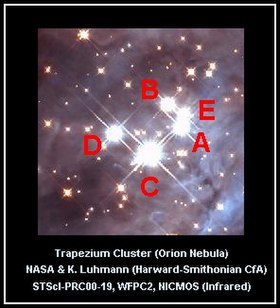 Trapezium stars | |
| Observation data Epoch J2000 Equinox J2000 | |
|---|---|
| Constellation | Orion |
| Right ascension | 05 35 15.84743 |
| Declination | −05° 23′ 14.3441″ |
| Apparent magnitude (V) | 6.72 - 7.65 |
| Characteristics | |
| Spectral type | B0.5V |
| Variable type | Algol |
| Astrometry | |
| Proper motion (μ) | RA: 4.81±0.10 mas/yr Dec.: −2.53±0.12 mas/yr |
| Parallax (π) | 2.626 ± 0.100 mas |
| Distance | 1,240 ± 50 ly (380 ± 10 pc) |
| Absolute magnitude (MV) | −2.80 |
| Details | |
| A1 | |
| Mass | 15.3 M☉ |
| Radius | 4.5 R☉ |
| Luminosity | 16,200 L☉ |
| Surface gravity (log g) | 4.30 cgs |
| Temperature | 30,700 K |
| Age | <2.5 Myr |
| A3 | |
| Mass | 2.5 - 2.7 M☉ |
| Radius | 6.4 R☉ |
| Details | |
| A2 | |
| Mass | 4 M☉ |
| Other designations | |
| 41 Ori A, V1016 Ori, BD−05 1315A, HD 37020, HIP 26220, HR 1893 | |
| Database references | |
| SIMBAD | data |
Theta Orionis A (θ Ori A) is a variable trinary star in the constellation Orion. Its apparent magnitude range is 6.72 to 7.65 with a period of 65.432 days. It is one of the main stars in The Trapezium in Orion, along with B, C, and D, as well as the fainter E.
Variability

θ Orionis A varies in brightness, showing dips from magnitude 6.72 to 7.65 every 65.432 days. These are caused by eclipses of a close binary pair. θ Orionis A has been assigned the variable star designation V1016 Orionis.
System
θ Orionis A is a star system with three known members. Components A1 and A2 are separated by around 0.2 ", while A1 is itself a spectroscopic binary with two stars separated by about 1 au.
θ Orionis A1 is an eclipsing binary but the secondary is not detected in the spectrum and is far less luminous than the primary. The secondary has been proposed to be a T Tauri star, possibly of spectral class A. The orbit is not well-defined but appears to be eccentric.
θ Orionis A2 is approximately one magnitude fainter than A1 and 0.2" away. This corresponds to a projected separation of 90 AU. The relative motion of the two stars has been measured and they are slowly getting closer together but it has not been possible to derive an orbit. The relative motion of the two stars could simply be a straight line, but it is calculated that they are gravitationally bound.
References
- ^ Kounkel, Marina; Hartmann, Lee; Loinard, Laurent; Mioduszewski, Amy J.; Dzib, Sergio A.; Ortiz-León, Gisela N.; Rodríguez, Luis F.; Pech, Gerardo; Rivera, Juana L.; Torres, Rosa M.; Boden, Andrew F.; Evans, Neal J.; Briceño, Cesar; Tobin, John (2014). "The Gould's Belt Very Large Array Survey. III. The Orion Region". The Astrophysical Journal. 790 (1): 49. arXiv:1406.1809. Bibcode:2014ApJ...790...49K. doi:10.1088/0004-637X/790/1/49. S2CID 119231061.
- ^ Samus, N. N.; Durlevich, O. V.; et al. (2009). "VizieR Online Data Catalog: General Catalogue of Variable Stars (Samus+ 2007-2013)". VizieR On-line Data Catalog: B/GCVS. Originally Published in: 2009yCat....102025S. 1. Bibcode:2009yCat....102025S.
- ^ Nieva, María-Fernanda; Przybilla, Norbert (2014). "Fundamental properties of nearby single early B-type stars". Astronomy & Astrophysics. 566: A7. arXiv:1412.1418. Bibcode:2014A&A...566A...7N. doi:10.1051/0004-6361/201423373. S2CID 119227033.
- ^ Kounkel, Marina; et al. (2017). "The Gould's Belt Distances Survey (GOBELINS) II. Distances and Structure toward the Orion Molecular Clouds". The Astrophysical Journal. 834 (2). 142. arXiv:1609.04041. Bibcode:2017ApJ...834..142K. doi:10.3847/1538-4357/834/2/142. S2CID 26439367.
- ^ Bossi, M.; Gaspani, A.; Scardia, M.; Tadini, M. (1989). "Orionis A - A pre-main sequence low Q binary system?". Astronomy and Astrophysics. 222: 117. Bibcode:1989A&A...222..117B.
- Grellmann, R.; Preibisch, T.; Ratzka, T.; Kraus, S.; Helminiak, K. G.; Zinnecker, H. (2013). "The multiplicity of massive stars in the Orion Nebula Cluster as seen with long-baseline interferometry". Astronomy & Astrophysics. 550: A82. arXiv:1301.3045. Bibcode:2013A&A...550A..82G. doi:10.1051/0004-6361/201220192. S2CID 6554786.
- "Download Data". aavso.org. AAVSO. Retrieved 1 October 2021.
- Lloyd, C.; Stickland, D. J. (November 1999). "The Nature of the Bright Early-Type Eclipsing Binary Theta 1 Ori A = V1016 Orionis". Information Bulletin on Variable Stars. 4809: 1. Bibcode:1999IBVS.4809....1L. Retrieved 8 February 2022.
- ^ Vitrichenko, E. A.; Klochkova, V. G. (2000). "A Spectroscopic Study of V1016 Ori". Astronomy Letters. 26 (2): 104. Bibcode:2000AstL...26..104V. doi:10.1134/1.20373. S2CID 119402387.
- ^ Petr, Monika G.; Coudé Du Foresto, Vincent; Beckwith, Steven V. W.; Richichi, Andrea; McCaughrean, Mark J. (1998). "Binary Stars in the Orion Trapezium Cluster Core". The Astrophysical Journal. 500 (2): 825. Bibcode:1998ApJ...500..825P. doi:10.1086/305751.
- Close, L. M.; Puglisi, A.; Males, J. R.; Arcidiacono, C.; Skemer, A.; Guerra, J. C.; Busoni, L.; Brusa, G.; Pinna, E.; Miller, D. L.; Riccardi, A.; McCarthy, D. W.; Xompero, M.; Kulesa, C.; Quiros-Pacheco, F.; Argomedo, J.; Brynnel, J.; Esposito, S.; Mannucci, F.; Boutsia, K.; Fini, L.; Thompson, D. J.; Hill, J. M.; Woodward, C. E.; Briguglio, R.; Rodigas, T. J.; Briguglio, R.; Stefanini, P.; Agapito, G.; et al. (2012). "High-resolution Images of Orbital Motion in the Orion Trapezium Cluster with the LBT AO System". The Astrophysical Journal. 749 (2): 180. arXiv:1203.2638. Bibcode:2012ApJ...749..180C. doi:10.1088/0004-637X/749/2/180. S2CID 119298839.
External links
- "Trapezium (Theta1 Orionis)". The Worlds of David Darling. Retrieved 31 July 2014.
- "Theta-1 Orionis". Retrieved 31 July 2014.
| Constellation of Orion | |||||||||||||
|---|---|---|---|---|---|---|---|---|---|---|---|---|---|
| Stars |
| ||||||||||||
| |||||||||||||
| Star clusters |
| ||||||||||||
| Nebulae |
| ||||||||||||
| Galaxies |
| ||||||||||||
| |||||||||||||